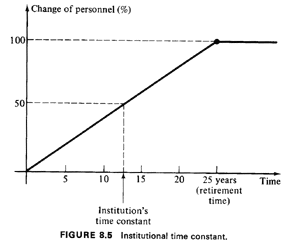


8.3.3 The User's AgencyThe institutional setting in which an intervention program takes place can suggest alternative implementation strategies. An agency that is accustomed to data collection and its use in management decision making can be contrasted to one in which decisions are solely "intuitive," based on judgment, experience, and pressures from citizens' groups. Some agencies are highly professional, utilizing standards of accountability; other are fraternal, often insular, choosing to do things based on historical tradition. Particularly for the more custom-bound agencies, considerable ingenuity is required of the analyst to arrive at an appropriate implementation plan. A major component of almost any plan should be building a broad base of support for the effort, as discussed below (see Section 8.3.5). All agencies must operate within various constraints, including those related to time, budget, and operations. A time constraint is a deadline of some type. It may refer to the fiscal year, calendar year, contract obligations, elections, or reappointments. Most urban decision makers operate under tight time constraints. Many, it seems, always work in a near-crisis environment. Thus, few city-specific studies have available the time that is often desired by the model implementors. Compromises must be reached. The realities of deadlines must be faced. There are too many models now lying peacefully in the graveyard of models which consumed 80 to 90 percent of a project's efforts, leaving all too little time for the remaining processes (e.g., user training, analysis of production runs, instituting operating changes) that must be undertaken in a successful model implementation effort. Budgeting constraints often limit the duration of an intervention program and the types of analyses that can be performed. On the positive side, limited budgets also imply ceilings on labor pools, which should enhance in the future urban managers' interest in effective utilization of existing or projected personnel. A system's operating constraints limit the range of alternatives that may be examined in a model-based analysis. For instance, the State of New York had on its books for over 50 years a "three-platoon law" that limited the scheduling flexibility of police personnel. In general, the constraints with which one deals may be legal, financial, political, or technical. The highly visible constraints, such as state laws or collective bargaining agreements, are relatively easy to incorporate into an analysis. The difficult ones are invisible at first (remember the star halfback who was initially assigned to a rival school?). In an urban environment, it is our contention that virtually no change of significance can occur without some hitherto invisible constraints rising to the surface. No model can be expected to incorporate awareness of the existence of star halfbacks; rather, the model implementation process should be designed to anticipate and correct for such hidden constraints when they come to light. Finally, an institution can be considered to have natural time constants, reflecting typical lengths of time required for it to accept and incorporate an attempted change. A fairly simple change (e.g., a rescheduling of personnel) may be adopted fully within days or weeks. A more fundamental change, perhaps markedly affecting the institution, may require a substantial turnover in current personnel before full acceptance. This would be necessary to diminish the importance of "institutional memories," which are often supportive of traditional policies. Here, we find it convenient to think of an agency's institutional time constant as the time to achieve a 50 percent turnover in personnel. For a system operating in equilibrium with, say, a 25-year retirement plan, its institutional time constant would be (25/2) = 12.5 years (Figure 8.5). This is a sobering thought for those who expect instant cures to various urban problems. 
|


